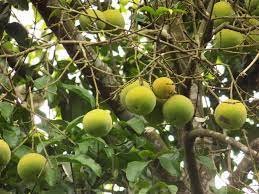NAME: Ficus thonningii
FAMILY: Moraceae
COMMON NAMES: Thonning's Fig, Bladder Fig
LOCAL NAMES: Odan abaa,opoto,aba-odan ,Guluba
MORPHOLOGICAL DESCRIPTION: Ficus thonningii is a medium-sized deciduous tree that can grow up to 15 meters in height. It has a spreading crown and a trunk with grayish-brown bark. The leaves of Ficus thonningii are alternate, simple, and leathery, with a lanceolate or elliptic shape. They measure approximately 5-10 centimeters in length and have a smooth, glossy surface. The tree produces small greenish-yellow flowers that are inconspicuous. The fruit of Ficus thonningii is a fig, which is green when unripe and turns yellow or orange when mature.
USEFUL PART(s): The fruit and bark of Ficus thonningii are the most commonly used parts of the tree.
GENERAL USES:
Culinary: The ripe figs of Ficus thonningii are edible and can be eaten fresh or used in cooking. They have a sweet and mildly acidic taste.
Medicinal: Various parts of the tree, including the bark and roots, have traditional medicinal uses. They are believed to possess anti-inflammatory, antifungal, and antimicrobial properties and are used in treating skin conditions, stomach ailments, and respiratory issues.
Wood: The wood of Ficus thonningii is used in the construction of furniture, tool handles, and other wooden crafts.
GEOGRAPHIC DISTRIBUTION: Ficus thonningii is native to tropical and subtropical regions of Africa. It can be found in countries such as Nigeria, Ghana, Cameroon, and Sudan.
WHY IS IT GREEN? Ficus thonningii, like all other plants, appears green due to the presence of chlorophyll in its cells. Chlorophyll is a pigment that captures sunlight and plays a vital role in photosynthesis, the process by which plants convert light energy into chemical energy.
ENVIRONMENTAL IMPACT: Ficus thonningii contributes to the local ecosystems where it grows by providing habitat and food sources for various animals. Its figs attract birds and mammals, which aid in seed dispersal. Additionally, the tree helps in soil stabilization and erosion control.
FUN FACT: Ficus thonningii has an interesting adaptation known as cauliflory, where its flowers and fruits grow directly from the trunk or older branches. This unique characteristic allows for efficient pollination and protects the developing fruits from ground-dwelling herbivores.
Further Reading:
"The Useful Plants of West Tropical Africa" by H.M. Burkill
"Trees of Africa: A Field Guide" by Jonathan Timberlake and Jenny Byngton





















